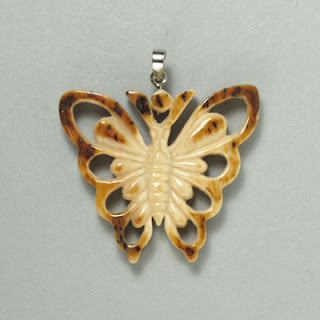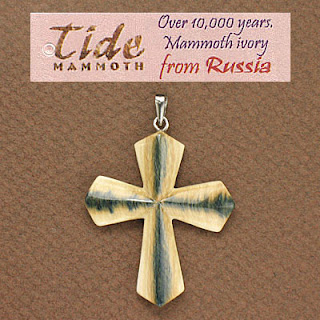Special
Characteristic of Mammoth Ivory Tusk – Nice Fossil Bark
One of
the easiest ways to distinguish mammoth ivory tusk from elephant tusk is by the
color of the tusk surface.
Mammoth
Ivory is the ivory tusks of the Woolly Mammoth (Mammuthus Primigenus also known
as the Mastodon) which has been extinct for more than 10,000 years. Mammoth
Ivory has been found in Europe, North America and Asia since the end of the
last ice age. The Woolly Mammoth roamed across the land bridge between Siberia
and Alaska during the ice age when parts of Alaska and the Yukon in Canada were
free of ice.
Mammoth ivory were buried under the ice for over 10,000 years. It has taken on its beautiful
patterns and colors by absorbing minerals from the artic soil. The colors seen
include tan, light brown, orange, golden brown, and chocolate brown to even
black; occasionally a blue or green color is also seen. The outside bark is
sometimes very colorful as it was in direct contact with minerals in the soil
and the elements. For the appearance of mammoth ivory tusk, please
refer to the links below:
http://www.youtube.com/watch?v=Kcr-0ED7ZmI
For modern elephant ivory, they are only in ivory color because they are freshly cut from elephant without any buried. It will not have brownish, blue-green or grey colors. Please find the attached picture for the image of elephant ivory.
To be a wise consumer, please check and make sure
you are buying real mammoth ivory products by checking the color of the tusk
surface. In the following paragraphs, I will show you the mammoth ivory
products with observable fossil mammoth bark.
Mammoth tusk carving and sculpture via elephant
tusk carving and sculpture
You are see from the pictures below, the color of
the whole elephant tusk carving is in ivory color without any other color.
While from the picture of mammoth ivory tusk
carving, you can see there are brown fossil bark at the surface of the tusk. In
the middle of the tusk, it is also in natural ivory color because only the
surface of the mammoth tusk were fossilized by absorbing the mineral from
surrounding soil during 10,000 years of burial.
Mammoth ivory tusk carving:
Mammoth
ivory sculptures:
#37514
#37657
Elephant ivory carvings:
Because
of the special natural bark color of mammoth ivory, many people would like to
use it to make the knife handles. It is impossible for elephant ivory to make
such colorful and beatiful knife scales.
For
details, please find the link below: http://www.youtube.com/watch?v=vunPVbXeoZk
For
jewelry and beads, besides ivory color, mammoth ivory can make brown, blue,
green , and beige color beads which provide more selection and ideas for
designers.
http://www.youtube.com/watch?v=87PyoPVK6Vs
As the
bark color and also the degree of fossilization of each mammoth tusks are
different because they are naturally formed by the environment which they were
burial. This feature makes the products looks unique and special by the colors
and pattern of the cracks. You can see this from the few samples of mammoth
ivory bark pendants.
Mammoth
ivory bark pendants:
Ac0036-001,
Ac0036-002, ac0036-003
Ac0059b,
ac0059c, ac0059d
Elephant
ivory jewelry:
For
elephant jewelry and bead, you can see there is only one color – Ivory.
Based on
the above information, I believe you can be a professional in distinguishing
mammoth ivory between elephant ivory.

















